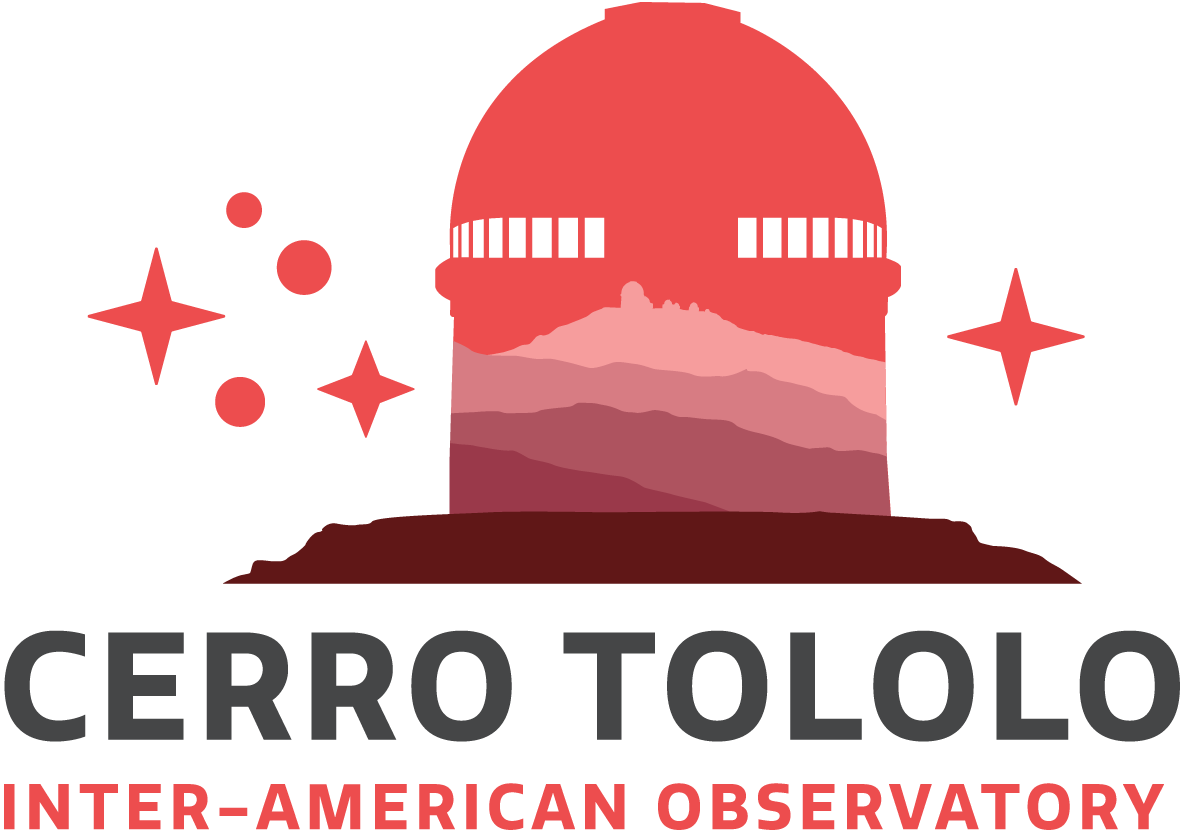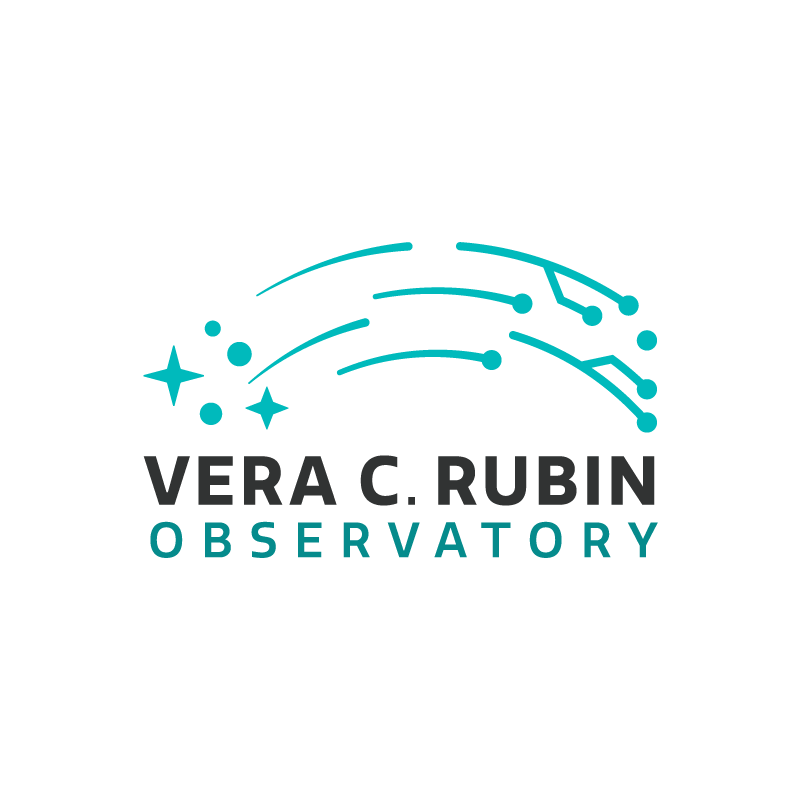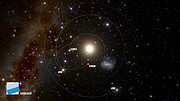Fastest Orbiting Asteroid Discovered at NOIRLab’s CTIO
About a kilometer across, space rock 2021 PH27 is the Sun’s nearest neighbor
23 August 2021
Using the powerful 570-megapixel Dark Energy Camera (DECam) in Chile, astronomers just ten days ago discovered an asteroid with the shortest orbital period of any known asteroid in the Solar System. The orbit of the approximately 1-kilometer-diameter asteroid takes it as close as 20 million kilometers (12 million miles or 0.13 au), from the Sun every 113 days. Asteroid 2021 PH27, revealed in images acquired during twilight, also has the smallest mean distance (semi-major axis) of any known asteroid in our Solar System — only Mercury has a shorter period and smaller semi-major axis. The asteroid is so close to the Sun’s massive gravitational field, it experiences the largest general relativistic effects of any known Solar System object.
The asteroid designated 2021 PH27 was discovered by Scott S. Sheppard of the Carnegie Institution of Science in data collected by the Dark Energy Camera (DECam) mounted on the Víctor M. Blanco 4-meter Telescope at Cerro Tololo Inter-American Observatory (CTIO) in Chile. The discovery images of the asteroid were taken by Ian Dell’antonio and Shenming Fu of Brown University in the twilight skies on the evening of 13 August 2021. Sheppard had teamed up with Dell’antonio and Fu while conducting observations with DECam for the Local Volume Complete Cluster Survey, which is studying most of the massive galaxy clusters in the local Universe [1]. They took time out from observing some of the largest objects millions of light-years away to search for far smaller objects — asteroids — closer to home.
One of the highest-performance, wide-field CCD imagers in the world, DECam was designed for the Dark Energy Survey (DES) funded by the DOE, was built and tested at DOE’s Fermilab, and was operated by the DOE and NSF between 2013 and 2019. At present DECam is used for programs covering a huge range of science. The DECam science archive is curated by the Community Science and Data Center (CSDC). CTIO and CSDC are programs of NSF NOIRLab.
Twilight, just after sunset or before sunrise, is the best time to hunt for asteroids that are interior to Earth’s orbit, in the direction of the two innermost planets, Mercury and Venus. As any stargazer will tell you, Mercury and Venus never appear to get very far from the Sun in the sky and are always best visible near sunrise or sunset. The same holds for asteroids that also orbit close to the Sun.
Following 2021 PH27’s discovery, David Tholen of the University of Hawai‘i measured the asteroid’s position and predicted where it could be observed the following evening. Subsequently, on 14 August 2021, it was observed once more by DECam, and also by the Magellan Telescopes at the Las Campanas Observatory in Chile. Then, on the evening of the 15th, Marco Micheli of the European Space Agency used the Las Cumbres Observatory network of 1- to 2-meter telescopes to observe it from CTIO in Chile and from South Africa, in addition to further observations from DECam and Magellan, as astronomers postponed their originally scheduled observations to get a sight of the newly found asteroid.
“Though telescope time for astronomers is very precious, the international nature and love of the unknown make astronomers very willing to override their own science and observations to follow up new, interesting discoveries like this,” says Sheppard.
Planets and asteroids orbit the Sun in elliptical (or oval-shaped) orbits, with the widest axis of the ellipse having a radius described as the semi-major axis. 2021 PH27 has a semi-major axis of 70 million kilometers (43 million miles or 0.46 au), giving it a 113-day orbital period on a elongated orbit that crosses the orbits of both Mercury and Venus [2].
It may have begun life in the main Asteroid Belt between Mars and Jupiter and got dislodged by gravitational disturbances from the inner planets that drew it closer to the Sun. Its high orbital inclination of 32 degrees suggests, however, that it might instead be an extinct comet from the outer Solar System that got captured into a closer short-period orbit when passing near one of the terrestrial planets. Future observations of the asteroid will shed more light on its origins.
Its orbit is probably also unstable over long periods of time, and it will likely eventually either collide with Mercury, Venus or the Sun in a few million years, or be ejected from the inner Solar System by the inner planets’ gravitational influence.
Astronomers have a hard time finding these interior asteroids because they are very often hidden by the glare of the Sun. When asteroids get so close to our nearest star, they experience a variety of stresses, such as thermal stresses from the Sun’s heat, and physical stresses from gravitational tidal forces. These stresses could cause some of the more fragile asteroids to break up.
“The fraction of asteroids interior to Earth and Venus compared to exterior will give us insights into the strength and make-up of these objects,” says Sheppard. If the population of asteroids on similar orbits to 2021 PH27 appears depleted, it could tell astronomers what fraction of near-Earth asteroids are piles of rubble that are loosely held together, as opposed to solid chunks of rock, which could have consequences for asteroids that might be on a collision course with Earth and how we might deflect them.
“Understanding the population of asteroids interior to Earth’s orbit is important to complete the census of asteroids near Earth, including some of the most likely Earth impactors that may approach Earth during daylight and that cannot easily be discovered in most surveys that are observing at night, away from the Sun,” says Sheppard. He adds that since 2021 PH27 approaches so close to the Sun, “...its surface temperature gets to almost 500 degrees C (around 900 degrees F) at closest approach, hot enough to melt lead”.
Because 2021 PH27 is so close to the Sun’s massive gravitational field, it experiences the largest general relativistic effects of any known Solar System object. This reveals itself as a slight angular deviation in the asteroid’s elliptical orbit over time, a movement called precession, which amounts to about one arcminute per century [3].
The asteroid is now entering solar conjunction when from our point of view it is seen to move behind the Sun. It is expected to return to visibility from Earth early in 2022, when new observations will be able to determine its orbit in more detail, allowing the asteroid to get an official name.
Notes
[1] The Local Volume Complete Cluster Survey (LoVoCCS) is an NSF NOIRLab survey program that is using DECam to measure the dark matter distribution and the galaxy population in 107 nearby galaxy clusters. These deep exposures will allow a clean comparison of faint variable objects when combined with data from Vera C. Rubin Observatory.
[2] 2021 PH27 is only one of around 20 known Atira asteroids that have their orbits completely interior to the Earth’s orbit.
[3] Observation of Mercury’s precession puzzled scientists until Einstein’s general theory of relativity explained its orbital adjustments over time. 2021 PH27’s precession is even faster than Mercury’s.
More information
This research was reported to the Minor Planet Center.
NSF NOIRLab (National Optical-Infrared Astronomy Research Laboratory), the US center for ground-based optical-infrared astronomy, operates the international Gemini Observatory (a facility of NSF, NRC–Canada, ANID–Chile, MCTIC–Brazil, MINCyT–Argentina, and KASI–Republic of Korea), Kitt Peak National Observatory (KPNO), Cerro Tololo Inter-American Observatory (CTIO), the Community Science and Data Center (CSDC), and Vera C. Rubin Observatory (operated in cooperation with the Department of Energy’s SLAC National Accelerator Laboratory). It is managed by the Association of Universities for Research in Astronomy (AURA) under a cooperative agreement with NSF and is headquartered in Tucson, Arizona. The astronomical community is honored to have the opportunity to conduct astronomical research on Iolkam Du’ag (Kitt Peak) in Arizona, on Maunakea in Hawai‘i, and on Cerro Tololo and Cerro Pachón in Chile. We recognize and acknowledge the very significant cultural role and reverence that these sites have to the Tohono O'odham Nation, to the Native Hawaiian community, and to the local communities in Chile, respectively.
The DOE Office of Science is the single largest supporter of basic research in the physical sciences in the United States and is working to address some of the most pressing challenges of our time.
Links
Contacts
Scott Sheppard
Earth and Planets Laboratory
Carnegie Institution for Science
Email: ssheppard@carnegiescience.edu
Lars Lindberg Christensen
NSF NOIRLab
Head of Communications, Education & Engagement
Cell: +1 520 461 0433
Email: lars.christensen@noirlab.edu
About the Release
| Release No.: | noirlab2123 |
| Facility: | Víctor M. Blanco 4-meter Telescope |
| Instruments: | DECam |
| Science data: | 2022AJ....164..168S |















